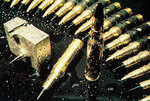It can be classified as a weak HMG yes, but it wasnt weak ! It could easely penetrate the thin skin of an airplane and most of whatever behind it. The 7.92mm S.m.K.H. projectile could penetrate 20mm of 90 degree armor at 550m 
The Normal Vo for the 7.92mm machineguns were 890m/s.
The Normal Vo for the 7.92mm machineguns were 890m/s.


